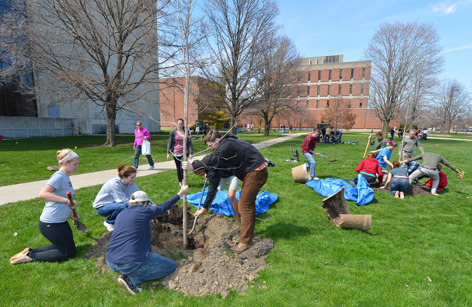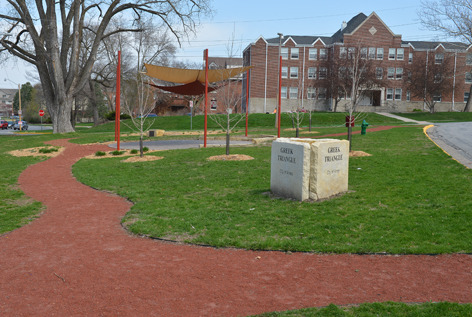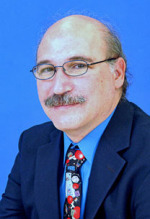Arbor Day activity

Eight trees were added to the landscape surrounding the College of Design April 25 as part of the annual Arbor Day observance. Students in the landscape architecture program planted the trees -- a variety of burr oaks (five) and chinkapin oaks (three). The trees are native to Iowa and drought tolerant, following this year's Arbor Day planting theme. Photo by Bob Elbert.
Student technology fees fund loaner laptops, Reiman Gardens chronicle, more
Loaner laptops, an operating room camera that allows veterinary medicine students to watch and learn and a digital chronicle of every plant at Reiman Gardens -- these are among the technological improvements that will be funded with more than $336,000 in student technology fees next fiscal year.
Every year, the Computation Advisory Committee (CAC), a group made up of faculty, staff and students across the university, decides how to spend a portion of the funds collected through the student technology fee. The committee looks for projects that encourage innovative use of technology to enhance student experiences. CAC recently awarded $336,493 from FY14 funds to 10 projects.
The CAC funds will help fund or fully fund projects to:
-
Replace 30 new laptops for a student laptop loan program, sponsored by Information Technology Services (ITS) and Government of the Student Body. Approximately 100 laptops are available for free checkout through ITS, 1200 Communications Building. Allocation: $65,671.
-
Beef up the GIS Design Computing Lab (526 College of Design) so that it can be open to any students doing homework, projects or research involving geographic information systems. This will alleviate some of the load on the increasingly busy GIS teaching computer lab in 248 Durham Center. Funds will be used for computers and software. Allocation: $16,350.
-
Replace 50 outdated user stations in a student-athlete computer lab in the Hixson-Lied Student Success Center. The old stations will be replaced with low-cost, low-maintenance stations. The computer lab is available to more than 450 student-athletes. Allocation: $23,512.
-
Upgrade multimedia technology in two rooms in the Hixson-Lied Student Success Center. The classrooms, which accommodate 60 students each, are used by multiple university departments. The upgrade includes new projection systems. Allocation: $14,983.
-
Purchase an operating room camera that integrates into the surgical light system in the Lloyd Veterinary Medical Center. The camera will enhance student learning in veterinary surgery, allowing HD video streaming, recording and on-demand playback of surgical procedures. Allocation: $29,694.
-
Provide 15 high-quality, portable sound recorders for student checkout. These devices will give students access to professional, easy-to-use sound recording for use in their research and studio projects. The equipment will be housed in the College of Design, but can be checked out by any Iowa State student. Allocation: $7,651.
-
Fund equipment, software and student help to document and map all the plants at Reiman Gardens. Once the database has been completed, a public web interface will provide online access to information and maps of Reiman Gardens collections, which include more than 10,000 plant species and cultivars. Academic programs in five colleges currently use Reiman Gardens for classes, labs and research programs. The new system should be available for academic use by fall semester 2014. Allocation: $60,520.
-
Replace obsolete MacBooks in the Apple Mobile Learning Lab, which is used for upper-level classes in ecology and evolutionary biology. The mobile lab provides a flexible on-demand solution for classes with computational requirements, but no permanent computer lab. Allocation: $30,873.
-
Help fund a year's salary for a medical illustrator working on an ongoing project to create realistic surgical simulations that eventually may allow doctors and students to practice surgical procedures in the virtual world before working on real patients. The illustrator, using CT and MRI images and cross sectional images of frozen specimens, will create extremely accurate 3D renderings of the entire anatomy of an animal. Researchers in the Colleges of Veterinary Medicine and Engineering are involved in the project. Allocation: $67,239.
-
Purchase 25 iPads in the College of Design. This project will provide graphic design students and other students access to iPads for designing and presenting their designs. Allocation: $20,000.
Some units go on summer hours May 13
Beginning Monday, May 13, some university offices will implement flexible summer hours, allowing employees to work from 7:30 a.m. to 4 p.m. with a shortened lunch break.
Units participating in summer hours must have schedules that maintain good service to our students, prospective students and other clients and customers, said Miles Lackey, associate vice president and chief of staff. Units' schedules also need approval from the appropriate dean, vice president or senior VP.
President, VP, deans offices staffed 8-5
Lackey said the offices of the president, vice presidents and senior vice presidents and deans will be staffed this summer from 8 a.m. to 5 p.m.
Summer hours begin the Monday after spring commencement and conclude no later than a full week before fall semester begins. For this year, that period is Monday, May 13, through Friday, Aug. 16.
More information on Iowa State's flexible hours program during the summer, Thanksgiving week, and winter and spring breaks is online.
Joint project beautifies Greek neighborhood

A cooperative town-gown effort culminated in the transformation of a traffic island into a beautiful park space for students and community members.
The Greek Triangle project improved green space at the intersection of Sunset Drive and Pearson Avenue (east of Ash Avenue), right in the heart of ISU's Greek neighborhood. The site -- designed by the Student Society of Landscape Architects -- now features crushed red brick pathways, perennial landscaping and a central patio area ringed by limestone seating and shaded by rich red and gold canvas tarps.
The project was two years in the making and dedicated at a ribbon-cutting event last month. It received funding from the city's neighborhood improvement program and was supported by the Office of Student Affairs, Government of the Student Body, Greek Alumni Alliance and Greek community. Photo by Bob Elbert.
Trash or treasure? University archives can help you decide
As the book closes on another academic year, you could help add a chapter to Iowa State's history. How? Clean out your office filing cabinets, closets and secret stashes, and transfer important papers, photographs, videos and other items to ISU Library's archives department.
"It's our job to document the history and value of the university," said Michele Christian, associate professor of library. "We're here to collect and preserve historically significant and valuable documentation."
What to keep
What may seem unimportant to you could be valuable to university archives. Iowa State has established a records retention policy to help departments know what to save and when. Here's a sampling of those items. A complete list is available online.
- Faculty meeting minutes
- Annual reports
- Audio/visual items
- Photographs
- Newsletters
- Documents that reflect the department's development
Interesting archives
Here are some examples of unique items housed in Iowa State's university archives:
- Muskrat skin stretcher from Paul Errington, research professor in zoology from 1932 to 1962
- The letter written by Jack Trice to himself on the eve of the Iowa State vs. Minnesota football game, where he sustained an injury which ended his life on Oct. 8, 1923
- A freshman beanie from 1918
- Carrie Chapman Catt's suffrage buttons from the late 19th and early 20th centuries
- The 1895 death mask of Margaret Stanton, wife of Edgar Stanton, who purchased the first carillon bells in Iowa State's campanile as a memorial to her
University archives offers tours of its facility to student groups and organizations. Contact Michele Christian, 4-4216, to make arrangements.
University archives also wants 3D items that reflect Iowa State's history. Some examples include Veishea and homecoming ephemera, faculty awards, trophies and almost anything that documents Iowa State's development.
If you need help determining what should be saved, the university archives staff is ready, willing and able to lend a hand. They even will help pack up materials. Contact them at 4-6672 or at archives@iastate.edu.
What to toss
Not everything is archive-worthy. Some items that should be thrown out include:
- Receipts
- Student rosters
- Grade books
- Anything that could infringe on a student's privacy
A list of items not accepted by university archives is available online (scroll down to see this list).
The transfer process
Before stockpiling every report, photograph and research paper that your department has produced for the past 20 years, contact university archives (4-6672) and let the staff know what you have. They will evaluate the items and make arrangements to have them transferred from your building to the library.
From there, the archives staff logs the materials, organizes the information into a database and places items in acid-free folders and boxes. The folders and boxes are then filed in a humidity- and temperature-controlled storage area, which houses approximately five miles of shelving.
University archives stores materials for free, and all information still is accessible once it moves to permanent storage. Departments are strongly encouraged to transfer files and items to university archives.
Lied Center remains open during west side earthwork
Work to construct an earthen berm around the Lied recreation facility moved to the west (front door) side of the building this week. The west doors remain open, but the sidewalk from Beach Road will be closed for four to six weeks, depending on weather. Access to the front doors is from either the south or northwest parking lots.
The project, designed to protect the Lied Center during Squaw Creek flooding, includes an earthen berm between the building and parking lots, varying in height from 5 to 8 feet. Where the berm intersects sidewalks and the front plaza, it will be supplemented during periods of threatened flooding with an interlocking plank system, similar to that installed two years ago to protect door openings at the Hilton and Scheman buildings. The Federal Emergency Management Agency approved the plan; FEMA funds will cover an anticipated 75 percent of the cost.
The flood protection plan will require moving William King's Stride sculpture to an adjacent location. Beginning Friday, May 3, it will be temporarily removed and reinstalled later this summer.
Bike path remains closed
Due to weather delays and changes to the scope of the work, the bike path along the north side of Lied will remain closed for several more weeks. The target date to reopen it is Monday, May 20. Recommended alternate routes to campus from the east side are: University Boulevard (north) to Wallace Road or (south) to Lincoln Way.
Berm construction should wrap up by mid-June. Work to replace a glass curtain wall near the building's south entrance will begin this summer and be completed by early fall.
Ames Laboratory interim director named

Lograsso
Thomas Lograsso has been named interim director of the U.S. Department of Energy’s Ames Laboratory.
Lograsso will succeed Alex King, who is stepping down to lead the laboratory’s Critical Materials Institute, a $120 million DOE Energy Innovation Hub announced in January. Lograsso will assume the Ames Lab directorship as soon as funding for the Critical Materials Institute is received.
“We have had exceptional leadership of the Ames Laboratory under Alex King, and I am confident Tom will maintain the lab’s momentum as we search for a permanent director,” said Jonathan Wickert, senior vice president and provost.
A search committee will be formed in the coming weeks with the goal of naming the lab’s next director in 2014. The committee will be led by Mufit Akinc, professor of materials science and engineering; and Cynthia Jenks, assistant director for scientific planning and division director of chemical and biological sciences in the Ames Laboratory.
Lograsso holds bachelor’s, master’s and doctorate degrees in metallurgical engineering from Michigan Technological University. He has served as an Ames Laboratory scientist since 1988, and is currently interim deputy director and division director of materials sciences. He also is an adjunct professor of materials science and engineering at Iowa State.
Lograsso’s research interests include phase transitions in materials, quasicrystalline alloys, and the creation of new metallic alloys and compounds. He holds six patents, and is the author of more than 270 peer-reviewed articles.
The Ames Laboratory is a U.S. Department of Energy Office of Science national laboratory operated by Iowa State. The Ames Laboratory creates innovative materials, technologies and energy solutions, using its expertise, unique capabilities and interdisciplinary collaborations to solve global problems.
Regents approve P&T awards, off-campus apartment leases
The residence department received permission from the state Board of Regents April 25 to lease five off-campus apartment buildings for a year to temporarily boost its capacity. A Stanton Avenue high rise in Campustown will create space for about 300 students, and four apartment buildings under construction on Maricopa Avenue in southwest Ames will add space for another 200 students.
Two of six additional Frederiksen Court apartment buildings on the north side of campus will open in August, adding 240 beds. The other four buildings (about 480 beds) are scheduled to open during spring semester 2014. Iowa State's lease on the off-campus buildings will run from Aug. 1 to July 31, 2014.
"We think this is a good interim step until we have a better idea of how long we'll sustain this growth," residence director Pete Englin told board members. Leasing, furnishing and staffing the five buildings will result in a net loss of about $625,000 for the residence department next year, he said, noting that the community adviser-resident ratio at the off-campus sites will be nearly double what it is on campus.
Students must be at least 19 years old and in at least their second calendar year of college to live in one of the five buildings.
Residence officials are preparing for a bed shortage as high as 1,200 this fall, triggered by high rates of students opting to return to campus housing and another large freshman class. This deficit does not consider the use of residence hall dens as private rooms. Last fall, more than 400 students were assigned to converted dens.
Promotion and tenure
The board gave final approval to a list of promotions and/or tenure recommendations for 56 ISU faculty members. The list includes 32 promotions with tenure, 20 promotions for faculty previously tenured, one promotion without tenure and three tenure awards without promotion. The changes take effect this summer for the 2013-14 academic year.
Snapshot: ISU faculty
| Academic year | ||||||
| 2012-13 | 2011-12 | 2010-11 | ||||
| Tenured | 1,028 | 56% | 1,007 | 57% | 1,008 | 58% |
| Tenure track | 303 | 16% | 286 | 16% | 300 | 17% |
| Non-tenure track | 511 | 28% | 470 | 27% | 427 | 25% |
| Total | 1,842 | 1,763 | 1,735 | |||
New task force
Board president Craig Lang announced a task force that will review the model used for decades to distribute the General University portion of the state appropriations for higher education funding. Currently, Iowa State and the University of Iowa each receive 40 percent of the annual appropriation; the University of Northern Iowa receives the remaining 20 percent. General University funding provides annual operating funds, about $170 million this year at Iowa State, or 30 percent of the operating budget. General University funds exclude direct appropriations to about eight units or programs such as the Leopold Center, Vet Diagnostic Lab and Ag Experiment Station.
Lang asked that the group consider the distinct missions of the three schools as well as historical funding patterns and the future funding needs of each, and come up with a metrics set that better links dollars to priorities.
While no longer a regent, David Miles will chair the task force. Regent Katie Mulholland will serve on it, and they'll be joined by yet-unnamed representatives and alumni of the three universities. The group doesn't have a deadline yet for completing its work.
Salary policy discussion
The board received comments from faculty and staff representatives as it begins to consider salary increase policies for the year that begins July 1.
Faculty Senate president Suzanne Hendrich said that growth in student enrollment as the state rebounds from a recession places three main concerns on faculty minds:
- Enhancing the student educational experience even as student numbers outpace the growth in faculty numbers
- Enhancing their own research excellence in the face of declining federal research dollars
- Helping the state of Iowa be the best it can be
Hendrich said declining state appropriations haven't allowed the university to adjust salaries adequately for the increased demands on faculty. She noted that ISU faculty salaries remain "at the bottom" of its Peer 11 group. Hendrich also said that in a recent informal survey of faculty senators, "quality of life" issues -- include work/life balance but also salary and benefits -- is the most important category for the senate to address.
Professional and Scientific Council president David Orman, who works as an IT manager at the Center for Nondestructive Evaluation, shared two issues with the board: difficulty finding qualified applicants willing to work within Iowa State's salary range, and difficulty rewarding high-performing employees due to small funding pools for salary increases.
"From a compensation standpoint, currently there is little difference between an excellent, good or even sub-par performance review," he said. "More money for supervisors to make significant differences in compensation from year to year would help create meaningful performance incentives."
FY14 parking fees
The board approved parking permit increases for the year that begins July 1. All Iowa State permits, excluding motorcycle permits ($3 increase), will see a flat $10 increase. An annual permit in the Memorial Union ramp will go up $12. No increase was requested for hourly parking (meters and metered lots).
Parking revenue is used to maintain existing lots, build a reserve for additional parking and support the parking operation.
Parking permit increases
| Type of permit | Current | July 1, 2013 |
| 24-hour Reserved | $856 | $866 |
| Reserved | $481 | $491 |
|
General staff, Residence staff and Ames Lab staff |
$142 | $152 |
| Department | $142 | $152 |
| Vendor | $181 | $191 |
| Motorcycle | $47 | $50 |
| Memorial Union ramp | ||
| Annual | $486 | $498 |
| Fall, winter or spring | $208 | $214 |
In other business:
- The board approved a 0 percent increase next year for all residence hall and student apartment rates, as well as all dining meal plans, including semester meal block options and ISU Dining Dollar packs.
- President Steven Leath told the board that in the last nine months, Iowa State has raised $40 million for student scholarships toward the five-year, $150 million total he pledged in his installation address last fall. "We're doing our part to help reduce student debt," he said.
- The board approved the retirement date (May 24) for University of Northern Iowa president Ben Allen. Incoming president William Rudd will begin his duties on May 31. UNI executive vice president and provost Gloria Gibson will serve as acting president for the six days in between.
This was the final board meeting for regents Lang, Miles and Jack Evans, whose terms ended April 30. President pro tem Bruce Rastetter will serve as interim board president until a president is elected at the June 5 board meeting.
Stephens to feature a season of song, dance and laughs

Bill Cosby
The Iowa State Center unveiled its 2013-14 performing arts series at its preview event last night. This year's lineup balances a mix of Broadway hits, international performers and artistic styles.
The series kicks off with legendary comedian Bill Cosby on Oct. 18, and also includes four Broadway musicals. Memphis and The Addams Family make their inaugural tour stops at Stephens Auditorium, while encore performances of Mamma Mia! and Disney's Beauty and the Beast return to the stage. The Moscow Festival Ballet also returns to Ames, this time with a production of Cinderella.
Music concerts include Masters of the Fiddle, with Natalie MacMaster and Donnell Leahy; the Estonian National Symphony Orchestra, with solo cellist Narek Hakhnazaryan; the Ukulele Orchestra of Great Britain; Bela Fleck, Abigail Washburn and the Del McCoury Band; the Ten Tenors; the Australian Chamber Orchestra; and Jazz at Lincoln Center Orchestra, with Wynton Marsalis.
Donors can purchase or renew priority seating through June 7. Subscribers can receive priority seating and discounted ticket packages through Aug. 2 (pick five or more performances). The "pick three" ticket package is available through Sept. 9. Individual tickets go on sale to the public Sept. 9. Show details and ticket information are available on the Iowa State Center website.

